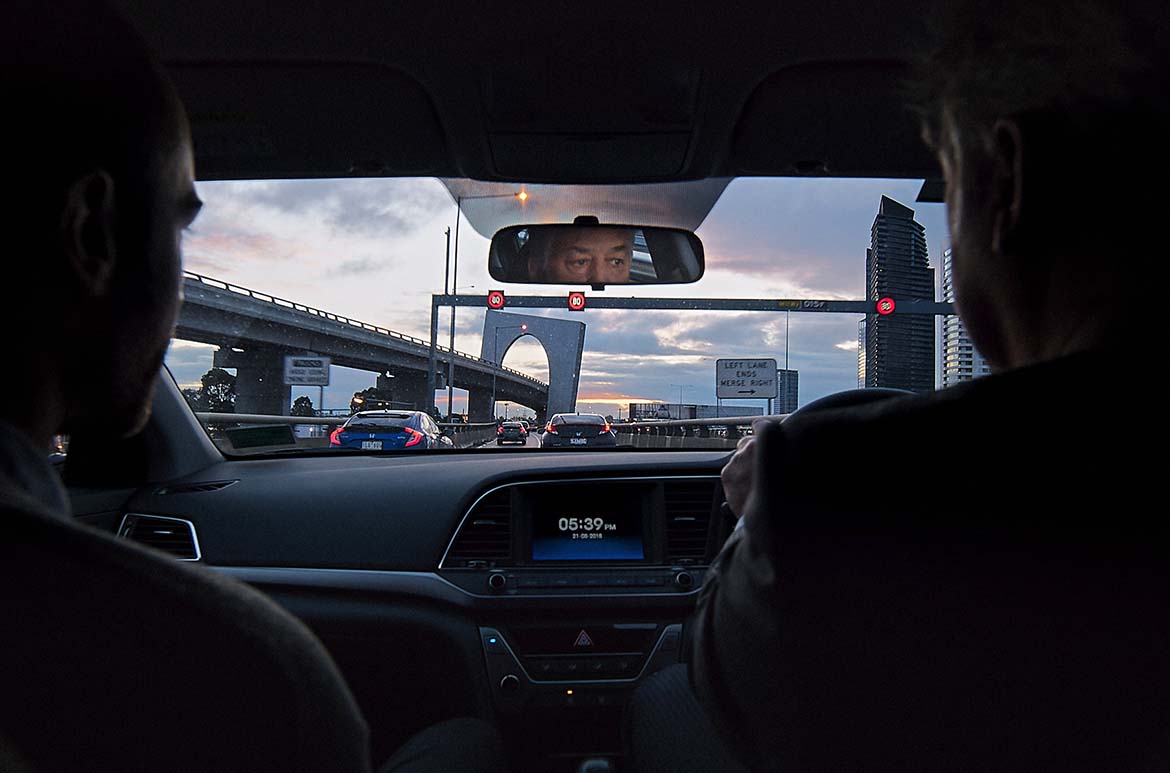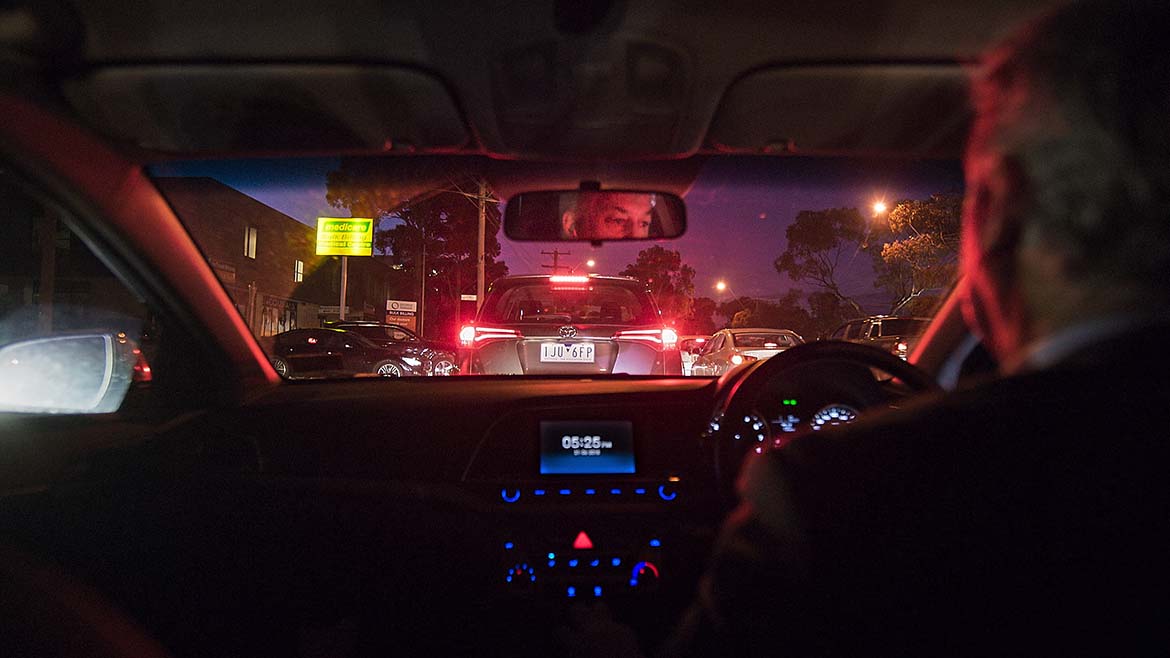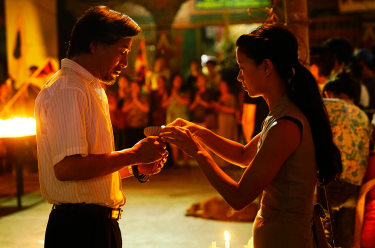As part of ‘The 10th Asia Pacific Triennial of Contemporary Art’ (APT10) Cinema program ‘Australian Next Wave’, we’re excited to present the Australian premiere of David Easteal’s debut feature film The Plains 2022.
The Plains is a mesmerising meditation on the tidal rhythms of life. The film takes place almost exclusively within a car driven by the middle-aged Andrew, whose peak hour commute to the outer suburbs of Melbourne presents a forum for reflections on memory, family and the vagaries of relationships.
After its premiere at the 2022 International Film Festival Rotterdam, the film has gone on to screen to acclaim at Cinéma du Réel in Paris and the Art of the Real festival in New York.
Robert Hughes, curator of ‘Australian Next Wave’, spoke with David, who is in New York attending the Art of the Real, about his film.
RELATED: 5 FILM SUGGESTIONS


Robert Hughes / David, could you please talk about the origins of ‘The Plains’. What led you to this story?
David Easteal / I initially met Andrew when we worked together at a legal centre in the outer suburbs of Melbourne. At that time we found out we lived near each other, and Andrew started to drive me home on occasions. It was a fairly long commute and in the car I would hear Andrew’s calls with his mother and his wife, Cheri, and I learnt about his life. During the year that we worked together Andrew’s mother’s dementia worsened and she passed away, and I could sense the effect this had on him. A friendship developed between us. I left the workplace but Andrew and I remained in contact and our shared commutes home over that year, and the conversations we had in the course of those commutes, formed the basis of the film.
The film was shot incrementally over 12 months. A lot happened over the year of shooting, and certain events which occurred in both Andrew’s life, as well as my life, during the year caused the film to evolve in unexpected ways – the film became a composite of recreating events that had occurred years prior, and reflecting upon more contemporaneous events, as well as fiction.
The film is primarily shot from the backseat of Andrew’s car as he speaks with a passenger or someone on the phone. What drew you to this unique setup and what challenges did it present?
I really love this perspective, whenever it is used in films I am drawn to it. I started using it in my own films in my last short film, Monaco, it’s the opening shot of that short film. The framing creates a very interesting visual dynamic between the stillness of the interior and the movement of the exterior. The windscreen becomes a frame within the frame of the film – providing a window to the outside world and a pure documentary element within the frame, in contrast to the ‘fiction’ of what is being depicted in the car. There’s a compositional blend of documentary and fiction – a composite attempted in the film’s narrative as well. Many parts of the film resonate for me because of the interplay between what was occurring and is being documented on the city streets in real time, something totally out of my control as a filmmaker, and what was going on in the narrative of the film occurring inside of the car. It was exciting to film that way, as an element of chance entered the makeup of each shot. I wished to make a film exploring the passage of time, and filming in this way provided an opportunity to capture the changing nature of the outside world over the course of the year.
I initially got to know Andrew through our discussions in the car, and I hoped to retain the openness of communicating in a car in the film. Cars are unique spaces for conversation, as both people are looking forward and not directly at each other, permitting more intimacy in a strange way. There is something confronting to me about a direct gaze, not looking directly at someone seems to allow the safety to go a bit deeper. The gaze of the lens of a camera is similarly confronting. This is one of the reasons that motivated me to position the camera in this way, rather than directing it at Andrew’s face. This angle would, on the face of it, present an obstacle for a character study – as most of the time we connect to someone’s interior world through their face. In the film we are largely restricted to Andrew’s eyes reflected in the rear-view mirror when his face is illuminated by the streetlights or the sun. However, I found we become more attuned to the subtle changes in his body language such as the way he sits, the tilt of his head, wrinkles around his eyes and the tone of his voice.
The dialogue has a free, naturalistic quality to it. How much of this was improvised? What was your process for developing it?
Whilst each month’s shoot was quite planned out and I had a somewhat clear idea as to where it would end up narrative-wise, the dialogue was pretty much all improvised, with perhaps a handful of exceptions. Each month I embarked on a process of writing what was to occur generally in the upcoming month, not the specifics of dialogue, keeping in mind the broader framework of the film that I had in mind. It was a process that necessarily involved ongoing discussions with both Andrew and Cheri, as many of the elements of the film were drawing from their lives. By the time we went to shoot each month, both Andrew and I were on the same page as to the areas or topics of conversation that were to occur during the shoot. Within the predetermined structure I think the dialogue had to be improvised for authenticity, neither Andrew or myself are professional actors, we never rehearsed and it is perhaps this improvisation which gives a sense of spontaneity.
You wrote, produced, directed and edited ‘The Plains’ – as well as appearing in front of the camera in various scenes. What was your experience like acting in multiple roles during the production?
I loved every part of the process, it was a pleasure working on this film. Prior to embarking on the film in this way I attempted to write a more traditional screenplay around a character based on someone like Andrew, and it didn’t work at all. Once I conceived of shooting in this way, ideas started to develop. It was really an incredibly invigorating year, we were constantly facing creative and practical challenges, and uncertainties. In shooting over such a prolonged time I attempted to remain open to developments rather than stay rigidly to a preconceived plan, and the film evolved in ways I could never have foreseen at the beginning, which was a really engaging process.
Similarly, editing the film ended up becoming a very engaging creative process. Whilst I initially did a cut placing one drive after the other, adhering to the initial structural or formal way we shot the film, the edit quickly became a process of letting go of these rigid formal conceits, and instead editing became focussed on rhythm, and emotion, which considerably opened up possibilities. I started to play around with many things, such as introducing the drone footage into the cut, and the film again seemed to evolve in unexpected ways for me.
Did you receive any support from funding bodies for the production of the film?
The production of the film was self-financed. The film received post production support through the Belfort International Film Festival Entrevues in France, where it received the Films en cours post-production support award. In-kind support was provided as a result of that prize by a few companies in Paris, where we completed the film, and I also received in-kind support from Arc Edit in Sydney, where we did the colour grade. I received marketing and travel support from Screen Australia to attend the International Film Festival Rotterdam, which unfortunately has yet to happen as the festival was forced online in January, however I understand there will be in-person screenings later in the year!
I think from the outset I was being a pragmatist, no funding body was going to fund a first-time feature project without a script, no known actors and only a handful of ideas as to what might happen in the film! I worked with a very small crew. I am very thankful to cinematographer Simon J. Walsh and sound recordist Steven Bond, who were pretty much the only crew for the shoot. It ended up being an extraordinary liberating way of working, over the year the connection between the four of us grew and it created a very intimate space, and I can sense that watching the film as the year progresses.
Were there any films or filmmakers from whom you drew particular inspiration for this project?
Not directly, but I’m sure there are many indirect sources of inspiration. I recall thinking back to the Lumiere brothers, and having a desire for a very simple approach to filmmaking – positioning the camera and observing what happens in the space before the lens for the time the camera is rolling, of course perhaps manipulating the action which occurs in that space. I was thinking about their 1895 film Workers Leaving The Lumière Factory in Lyon and the process of leaving work for the commute home, however rather than leaving the factory and walking on the streets with colleagues, I was interested in exploring the ‘dead time’ of the commute many now experience, leaving a white collar office job in a car and entering the evening rush hour to get home, together with thousands of others in their cars yet alienated from them.
The film gives importance to the element of time, which often disappears in film in favour of narrative progression, and to this end I used extended takes playing out in real time. I tend to be drawn to filmmakers who explore the element of time in some way – James Benning, Tsai Ming-Liang, Chantal Akerman, Hou Hsiao-Hsien all come to mind. I also love the films of Abbas Kiarostami, surely one of the the greatest filmmaker of cars, and of everyday life playing out in cars.
In this film I was drawn to explore repetition, and subtle variations within repetition, which is something I often seem drawn to in visual art and music, and was probably innately inspired by these art forms – I recall listening a lot to Bach at the time, as well as more contemporary minimalist composers – Tony Conrad, Steve Reich, John Cage, Terry Riley, Philip Glass to name a few. And perhaps also literary influences – there’s a repetitive, obsessive quality to the prose of Gerald Murnane which I like a lot, as well as a focus on landscape, time and memory, all of which I sought to explore in this film.
The film premiered at IFFR earlier this year and is now screening at international festivals. What has it been like to experience the rollout of your film? How has it been received by audiences?
The launch of the film was initially stalled by the pandemic, it was a bit of a bumpy ride getting the film released onto the festival circuit! Now that it finally is I’ve been delighted and surprised at the response the film has so far received. It’s really extraordinary to see the film resonate with different audiences around the world. I’m excited and a little nervous about Australian audiences finally seeing the film at Asia Pacific Triennial!
‘The Plains’ is screening as part of the APT10 Cinema program ‘Australian Next Wave’. What is your relationship with the independent filmmaking scene in Australia? Do you feel that there is a connected filmmaking movement happening in the country at the moment?
It’s an honour to be included in the program along with some really great Australian filmmakers, many of whom are friends and whose progress I’ve seen through making shorts. Of course people live in different cities, but I find there’s a lot of generosity and support shown within the community especially when it comes to providing advice, discussing ideas, watching edits, that type of thing, support that’s incredibly valuable when making work outside of traditional funding models.
I think film festivals in Australia are really instrumental in fostering community, as well as providing potential avenues for funding. Each year in Melbourne the filmmaking community really gathers together in the heart of winter to not only watch the films of that year from around the world but also each other’s work. It’s one of my favourite times of the year, and I always feel inspired. I felt very supported by the Melbourne International Film Festival through making shorts over the past decade, and met a number of the other filmmakers in the program there. It seems to be a time when the community really coalesces – you might not see some of the people the rest of the year, but for those couple weeks there’s a great sense of connection and celebration. I really hope it can be back in person this year, it’s been sorely missed. I’ll soon have the opportunity to present the film as part of the Sydney Film Festival which I’m really excited about. And of course, I’m very happy to come up to Brisbane soon for the screening at GOMA and hopefully meet some more of the Brisbane filmmaking community.
Dip into our Cinema blogs / View the ongoing Australian Cinémathèque program
QAGOMA’s Australian Cinémathèque presents curated programs, genre showcases and director retrospectives covering the world of film from crowd-pleasing fan favourites and cult classics to hard-to-find international cinema, rare 35mm prints and silent films with live musical accompaniment on the Gallery’s Wurlitzer organ originally installed in Brisbane’s Regent Theatre in November 1929.
‘Australian Next Wave’ presents a selection of Australian debut feature films and documentaries made since 2017, reflecting on works by artists who are at the vanguard of local independent filmmaking.
‘APT10 Cinema: Australian Next Wave’ / GOMA Cinemas / 4 December 2021 until 25 April 2022
#QAGOMA


watch the films of that year from around the world